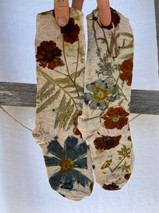The summer collection is dyed entirely with plants growing in the garden. Inspiration came from the growing wildness of the garden, with its harmoniously chaotic shapes and movement. Clear blue skies and weekly trips to the ocean are reflected in the indigo blues - grown in the leaves of Persicaria tinctoria and reduced in a dry-leaf indigo vat. The last inspiration came from the dryness of summer. Most people think of bright, vivid colors when they think of summer. In reality, the landscape is often brown and dry as the summer stretches on. Dynamic shades of pinkish-browns from dry Rumex seeds join terracotta coreopsis colors to bring this element of dry plants and earth.
Below you may find photos of finished pieces, information about the plants, and a visual reflection on the making of the Summer '24 collection. To purchase, visit the webshop for a limited selection or come to an in-person market or Open Studio.
In the Garden
The summer has come to a close. At least here at the studio, it was a weird one, with nighttime temperatures staying low (in the 12C) well through June. As you can imagine, this caused the dye flowers to take their sweet time, growing almost painfully slowly, and making it a particularly short summer season.
In this collection, these peculiarities of the season are reflected in the use of dry coreopsis flowers (from last year’s plants that bloomed late spring) for orange dye baths and perennial tanacetum plants for yellow dye baths. Early on in the season, sulfur cosmos and tanacetum were the primary sources of dye material for ecoprinting. Joining these classics was also St. John’s Wort - a native medicinal perennial that only successfully took hold after dozens of germinating efforts were seemingly fruitless. As the season progressed, pink cosmos burst into abundance allowing for compositions full of flowers. In July, with 0 healthy marigold plants, I started a full tray and direct-sowed an entire bed. Now at the end of the summer dyeing period, these marigolds are a reliable source of prints & colors.
Below you can see a sort of herbarium dedicated to the garden's summer protagonists. In order: Tanacetum, Cota tinctoria, Cota tinctoria, Persicaria tinctoria, Cosmos sulphureus, Persicaria tinctoria, Cosmos sulphureus, Coreopsis tinctoria, Persicaria tinctoria, Tagetes patula, Cosmos bipinnatus, Tagetes patula, Indigofera tinctoria, Bidens ferulifolia.
Garden Plants for Ecoprinting
Plantas in order left to right, top to bottom.
Cosmos bipinnatus: Native to the America' and in the asteraceae family, this annual flower can now be found growing all over the world. It exists in many varieties, each giving a unique print.
Cosmos sulphureus: A sister plant to Cosmos bipinnatus, also native to the Americas. It was an important dye plant to indigenous communities in the pre-columbian era.
Hypericum perforatum; aka St. John's Wort: Native to Portugal, this plant is internationally famous as an herbal medicine against depression and to aid sleep. It often grows on roadsides and in forested areas. It spreads through the root and can be excellent for covering exposed soil.
Coreopsis tinctoria: Another North American wildflower that is essential in my dye garden since the entire plants - stems, leaves & flowers - give orange!
Cota tinctoria; aka Dyer’s chamomile: In the sunflower family, this perennial European plant has traditionally been used to dye fabric golden yellow. I don't grow enough to dye with only the flowers, so the whole plant gets used for printing.
Scabiosa atropurpurae: A cultivated variety of a wildflower native to Portugal. When driving north, I can often spot wild scabiosa growing on roadsides. The deeper pigmentation of the flower makes it a star for ecoprinting.
Tanacetum vulgaris: A perennial North American plant that I use both for prints and a source of sunshine yellow shades. In the garden, it helps to attract beneficial insects like ladybugs.
Not photographed:
Tagetes; aka marigolds: Native to Mexico, but widely distributed all over the world. This easy-to-grow dye plant is most famous for its role in Hindu celebrations or Dia de Los Muertos festivities. There are over 50 recognized varieties/
I'll have seeds available for most of these plants in January. Seed sale will be announced on Instagram and via newsletter.
Garden plants for immersion dyeing:
Coreopsis : Info above
Tanacetum : Info above
Rumex crispus; aka Wild Dock: An indepensable plant in the Portuguese landscape, found all over the country. The plant creates a serious tap root and sheds hunderds of seeds making it a target of annihilation among gardeners. In the garden, the red sun-dried stalks are harvested for color.
Persicaria tinctoria; aka Japanese Indigo: I grow three main species of indigo (Japanese indigo, woad, and Indigofera) but the one I use for production is Japanese indigo because of its high indican concentration and ease to grow in Portugal. This year indigo blues were dyed in a dry-leaf vat, creating slightly lighter more turquoise shades.
Behind the Scenes:
















































































































Yorumlar